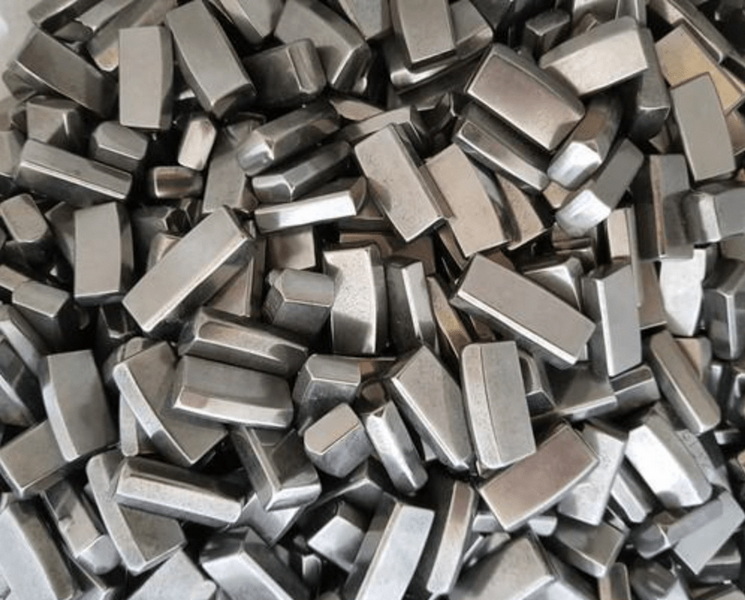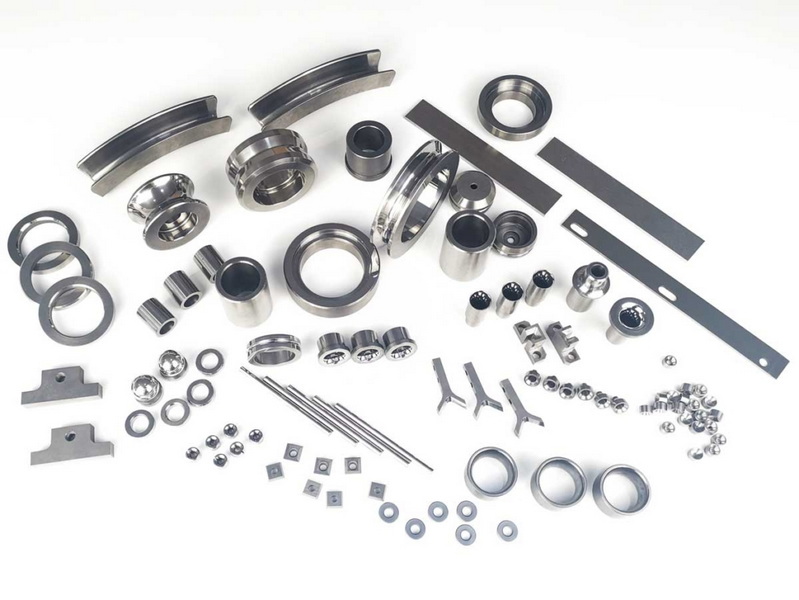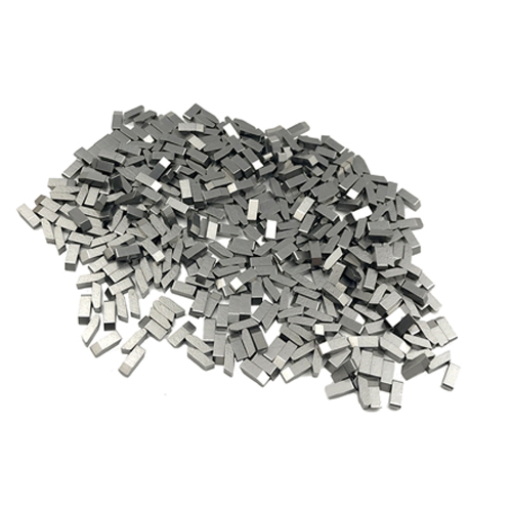Content Menu
● Introduction
● The Nature of Tungsten Carbide
● Electrical Conductivity of Tungsten Carbide
>> 1. Form of Tungsten Carbide
>> 2. Composition and Manufacturing Process
>> 3. Binder Content
>> 4. Application in Jewelry
● Thermal Conductivity of Tungsten Carbide
● Applications Leveraging Tungsten Carbide's Conductivity
● Other Notable Properties of Tungsten Carbide
>> Hardness and Wear Resistance
>> Strength and Rigidity
>> Heat Resistance
● Magnetic Properties
● Corrosion Resistance
● Comparison with Other Materials
● Applications of Tungsten Carbide
● Environmental and Health Considerations
● Future of Tungsten Carbide
● Conclusion
● Frequently Asked Questions
>> 1. Is tungsten carbide magnetic?
>> 2. How does the hardness of tungsten carbide compare to diamond?
>> 3. Can tungsten carbide be used in jewelry for people with metal allergies?
>> 4. How does the weight of tungsten carbide compare to other metals?
>> 5. Is tungsten carbide recyclable?
● Citations:
Introduction
Tungsten carbide, a compound of tungsten and carbon, is renowned for its exceptional hardness and durability. This material has found widespread applications across various industries, from manufacturing and mining to jewelry making. However, when it comes to its electrical properties, there's often confusion about whether tungsten carbide is conductive or not. In this comprehensive article, we'll explore the electrical conductivity of tungsten carbide, its properties, and applications, while addressing common misconceptions.

The Nature of Tungsten Carbide
Tungsten carbide (WC) is a composite material created by combining tungsten and carbon atoms in a specific ratio. Its unique properties stem from this atomic structure, which gives it characteristics different from pure tungsten or carbon alone.
Electrical Conductivity of Tungsten Carbide
The question of whether tungsten carbide is electrically conductive doesn't have a simple yes or no answer. The electrical conductivity of tungsten carbide depends on several factors:
1. Form of Tungsten Carbide
In its pure form, tungsten carbide is indeed electrically conductive. It has an electrical resistivity of about 20 μΩ·cm, which is comparable to that of some metals[7][17]. This means that pure tungsten carbide has an electrical conductivity of approximately 10% that of copper, which is considered a highly conductive metal[17].
2. Composition and Manufacturing Process
The electrical conductivity of tungsten carbide can vary depending on its composition and how it's manufactured. Most tungsten carbide products are not made of pure WC but are instead cemented carbides, which are composites of tungsten carbide particles held together by a binder material, usually cobalt or nickel[5].
3. Binder Content
The amount and type of binder used in cemented carbide can significantly affect its electrical properties. Generally, as the binder content increases, so does the electrical conductivity of the material[7].
4. Application in Jewelry
Interestingly, while tungsten carbide is conductive in its industrial form, tungsten carbide rings and other jewelry pieces are often non-conductive[1][16]. This is because the manufacturing process for jewelry involves powdering and molding the tungsten carbide, which changes its structure from metallic to ceramic[1].
Thermal Conductivity of Tungsten Carbide
While discussing electrical conductivity, it's worth noting that tungsten carbide also has interesting thermal properties:
- Tungsten carbide has a thermal conductivity of about 110 W/(m·K)[5].
- This makes it a better thermal conductor than many steels, conducting heat about twice as fast as alloy tool steel and carbon steel[13][14].
- However, its thermal conductivity is still only about one-third that of copper[12].
Applications Leveraging Tungsten Carbide's Conductivity
The electrical and thermal properties of tungsten carbide make it suitable for various applications:
1. Electrical Discharge Machining (EDM): The conductivity of tungsten carbide allows it to be shaped using EDM techniques[17].
2. Heat Sinks: Its good thermal conductivity makes it useful in applications where heat dissipation is crucial.
3. Cutting Tools: The thermal conductivity helps in dissipating heat generated during cutting operations, prolonging tool life.
4. Electronics: In some specialized electronic components where both hardness and conductivity are required.
Other Notable Properties of Tungsten Carbide
While our focus is on electrical conductivity, it's worth mentioning other remarkable properties of tungsten carbide:
Hardness and Wear Resistance
Tungsten carbide is extremely hard, ranking about 9 to 9.5 on the Mohs scale[5]. This makes it highly resistant to wear and abrasion, contributing to its popularity in cutting tools and wear-resistant components.
Strength and Rigidity
With a Young's modulus of approximately 530–700 GPa[5], tungsten carbide is incredibly rigid, about two to three times as rigid as steel[14].
Heat Resistance
Tungsten carbide retains its properties at high temperatures, performing well up to about 1000°F (538°C) in oxidizing atmospheres and up to 1500°F (816°C) in non-oxidizing atmospheres[14].

Magnetic Properties
Cemented carbides containing cobalt or nickel binders exhibit ferromagnetic characteristics at room temperature[17]. This property can be useful in certain applications but may need to be considered in others where magnetism could be problematic.
Corrosion Resistance
The individual tungsten carbide particles are resistant to most corrosive media[17], making the material suitable for use in harsh chemical environments.
Comparison with Other Materials
To put tungsten carbide's properties into perspective, let's compare it with some other common materials:
| Property | Tungsten Carbide | Steel | Copper | Aluminum |
| Electrical Conductivity | Moderate | Low | High | High |
| Thermal Conductivity | Moderate | Low | High | High |
| Hardness | Very High | Moderate | Low | Low |
| Density | High | Moderate | High | Low |
Applications of Tungsten Carbide
The unique combination of properties makes tungsten carbide valuable in various industries:
1. Manufacturing: Cutting tools, dies, and wear-resistant components.
2. Mining and Oil & Gas: Drill bits and mining equipment.
3. Jewelry: Scratch-resistant rings and watch bezels.
4. Automotive: Engine components and fuel injection nozzles.
5. Aerospace: Turbine engine components and landing gear parts.
Environmental and Health Considerations
While tungsten carbide offers many benefits, it's important to consider its environmental and health impacts:
- The mining and processing of tungsten can have significant environmental effects.
- Exposure to tungsten carbide dust, particularly when combined with cobalt, can pose health risks to workers in manufacturing settings.
- Proper safety measures and responsible sourcing are crucial in the tungsten carbide industry.
Future of Tungsten Carbide
As technology advances, new applications for tungsten carbide continue to emerge:
- Nanotechnology: Tungsten carbide nanoparticles are being explored for various applications.
- 3D Printing: Advancements in additive manufacturing are opening up new possibilities for creating complex tungsten carbide components.
- Sustainable Production: Research is ongoing to develop more environmentally friendly methods of producing and recycling tungsten carbide.
Conclusion
Tungsten carbide is a fascinating material with a complex set of properties, including its electrical conductivity. While pure tungsten carbide is electrically conductive, the cemented carbides used in most applications can vary in their conductivity depending on composition and manufacturing process. Its unique combination of hardness, strength, and thermal properties makes it invaluable in numerous industries.
As we continue to push the boundaries of material science, tungsten carbide remains a crucial player, with its applications constantly evolving. Understanding its electrical and other properties is key to leveraging this remarkable material effectively in both current and future technologies.

Frequently Asked Questions
1. Is tungsten carbide magnetic?
Tungsten carbide itself is not magnetic. However, cemented carbides containing cobalt or nickel binders can exhibit ferromagnetic properties due to these binder materials[17]. The magnetic permeability of WC-Co cemented carbides is generally low, ranging from 1.01 to about 12 when compared to a vacuum (with a value of 1)[17].
2. How does the hardness of tungsten carbide compare to diamond?
Tungsten carbide is extremely hard, ranking about 9 to 9.5 on the Mohs scale[5]. While this makes it one of the hardest known materials, it is still not as hard as diamond, which ranks 10 on the Mohs scale. However, tungsten carbide's combination of hardness and toughness often makes it more suitable than diamond for certain applications, particularly where impact resistance is important.
3. Can tungsten carbide be used in jewelry for people with metal allergies?
Yes, tungsten carbide jewelry is often considered hypoallergenic and suitable for people with metal allergies. This is because the tungsten carbide used in jewelry is typically alloyed with nickel or cobalt in such a way that these potential allergens are not exposed on the surface. However, individuals with extreme sensitivities should still exercise caution and consult with a dermatologist before wearing tungsten carbide jewelry[16].
4. How does the weight of tungsten carbide compare to other metals?
Tungsten carbide is significantly denser than many other metals commonly used in jewelry and industrial applications. Its specific gravity ranges from 1.5 to 2 times that of carbon steel[14]. This high density gives tungsten carbide jewelry a substantial, premium feel, but it also means that tungsten carbide components in industrial applications can be heavier than their steel counterparts.
5. Is tungsten carbide recyclable?
Yes, tungsten carbide can be recycled, and there is a growing industry focused on reclaiming and recycling tungsten carbide products. The recycling process typically involves crushing used tungsten carbide parts and chemically treating them to separate the tungsten from other materials. This recycled tungsten can then be used to create new tungsten carbide products. Recycling tungsten carbide is not only environmentally beneficial but also economically advantageous due to the high value of tungsten.
Citations:
[1] https://onlytungstenrings.com/is-tungsten-carbide-conductive/
[2] https://redwoodrings.com/blogs/redwood-rings-blog/are-tungsten-rings-conductive
[3] https://www.hyperionmt.com/en/Resources/materials/cemented-carbide/thermal-properties/
[4] https://create.vista.com/photos/tungsten-carbide/
[5] https://en.wikipedia.org/wiki/Tungsten_carbide
[6] https://www.industrialplating.com/materials/tungsten-carbide-coatings
[7] https://wesltd.com/capabilities/materials/tungsten-carbide/
[8] https://www.zhongbocarbide.com/news/Is-Tungsten-Carbide-A-Conductor.html
[9] https://www.alamy.com/stock-photo/tungsten-carbide.html
[10] https://www.itia.info/properties-intermediates/
[11] https://stock.adobe.com/search?k=tungsten+carbide
[12] https://www.linkedin.com/pulse/properties-tungsten-carbide-shijin-lei-2c
[13] https://www.kltcarbideusa.com/tungsten-carbide
[14] https://carbideprocessors.com/pages/carbide-parts/tungsten-carbide-properties.html
[15] https://upload.wikimedia.org/wikipedia/commons/7/72/Tungsten_carbide_inserts.jpg?sa=X&ved=2ahUKEwi-09jT9p2LAxWdjq8BHateAwMQ_B16BAgAEAI
[16] https://patrickadairdesigns.com/blogs/blog/best-non-conductive-wedding-rings-for-electricians
[17] https://www.linkedin.com/pulse/properties-tungsten-carbide-shijin-lei-2c
[18] https://www.carbideprobes.com/wp-content/uploads/2019/07/TungstenCarbideDataSheet.pdf
[19] https://www.shutterstock.com/search/tungsten-metal
[20] https://blog.fullertontool.com/tool-tip-thermal-conductivity-as-related-to-materials-vs.-carbide
















